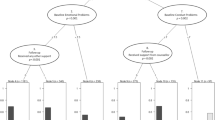Abstract
The impact of nonresponse on estimates of mental health problems was examined in a prospective teacher screen in a community survey of 9,155 7–9 year olds. For 6,611 of the children, parents consented to participation in the actual study (Responders), while for 2,544 children parental consent was not obtained (Nonresponders). The teacher screen involved assessment of a broad set of symptoms of mental health problems and functional impairment. Calculations of non-response coefficients, a function of effect sizes and non-response proportion, revealed only ignorable nonresponse bias for both mean scores and correlations. However, the results from binary logistic regressions revealed that children ascribed signs of mental health problems by their teachers were less likely to participate. This was most frequent among children with only moderate symptoms. However, it also involved children with high symptom scores related to inattention, hyperactivity, emotions and peer relationship problems. These findings suggest that measures based on effect size can underestimate the magnitude of non-response bias and that a logistic regression approach may be more appropriate for studies geared at estimating prevalence of mental health problems in children.


Similar content being viewed by others
References
Apter, A., Pauls, D. L., Bleich, A., Zohar, A. H., Kron, S., Ratzoni, G., et al. (1993). An epidemiologic study of Gilles de la Tourette’s syndrome in Israel. Archives of General Psychiatry, 50, 734–738.
Ehlers, S., Gillberg, C., & Wing, L. (1999). A screening questionnaire for Asperger syndrome and other high-functioning autism spectrum disorders in school age children. Journal of Autism and Developmental Disorders, 29, 129–141.
French, D. D., & Waas, G. A. (1985). Teachers’ ability to identify peer-rejected children: A comparison of sociometrics and teacher ratings. Journal of School Psychology, 23, 347–353.
Gerrits, M. H., van den OOrd, E. J. C. G., & Voogt, R. (2001). An evaluation of nonresponse bias in peer, self and teacher ratings of children’s psychosocial adjustment. Journal of Child Psychology and Psychiatry, 42, 593–602.
Goodman, R. (1999). The extended version of the strengths and difficulties questionnaire as a guide to child psychiatric caseness and consequent burden. Journal of Child and Adolescent Psychiatry, 40, 791–801.
Heiervang, E., Stormark, K. M., Lundervold, A. J., Heimann, M., Goodman, R., Posserud, M-B., et al. (2007). Psychiatric disorders in Norwegian 8- to 10-year olds: An epidemiological survey of prevalence, risk factors and service use. Journal of the American Academy of Child and Adolescent Psychiatry, 46, 438–447.
McMiller, W. P., & Weisz, J. R. (1996). Helpseeking preceding mental health clinic intake among African–American, Latino, and Caucasian youths. Journal of the American Academy of Child and Adolescent Psychiatry, 35, 1086–1094.
Noll, R. B., Zeller, M. H., Vanatta, K., Bukowski, W. M., & Davies, W. H. (1997). Potential bias in classroom research: Comparison of children with permission and those who do not receive permission to participate. Journal of Clinical Child Psychology, 26, 36–42.
Owens, P. L., Hoagwood, K., Horwitz, S. M., Leaf, P. J., Poduska, J. M., Kellam, S., et al. (2002). Barriers to children’s mental health services. Journal of the American Academy of Child and Adolescent Psychiatry, 41, 731–738.
Pavuluri, M. N., Luk, S-L., & McGee, R. (1996). Help-seeking for behavior problems by parents of preschool children: A community study. Journal of the American Academy of Child and Adolescent Psychiatry, 35, 215–222.
Roberts, R. E, Atkinsson, C. C., & Rosenblatt, A. (1998). Prevalence of psychopathology among children and adolescents. The American Journal of Psychiatry, 155, 715–727.
Rosenthal, R., & Rosenow, R. W. (1991). The essentials of behaviour research: Methods and data analysis. New York: McGraw-Hill.
Smith, T. W. (1983). The hidden 25 percent: An analysis of nonresponse on the 1980 general social survey. Public Opinion Quarterly, 47, 386–404.
Stang, A. (2003). Non-response research. An underdeveloped field in epidemiology. European Journal of Epidemiology, 18, 929–932.
Swanson, J. M. (1992). School-based assessments and interventions for ADD students. Irvine, CA: K.C. Publishing.
Thomsen, P. H. (1998). Obsessive compulsive disorder in children and adolescents. Clinical guidelines. European Child and Adolescent Psychiatry, 7, 1–11.
Weinberger, D. A., Tublin, S. K., Ford, M. E., & Feldman, S. S. (1990). Preadolescents social–emotional adjustment and selective attrition in family research. Child Development, 61, 1374–1386.
Acknowledgement
The authors want to thank Stein Atle Lie for valuable inputs to the statistical analyses. We thank the whole Bergen Child Study group for their involvement in carrying out the study. Finally we thank all teachers who filled out the questionnaire. Without their high participation rate this study would not have been possible.
Author information
Authors and Affiliations
Corresponding author
Additional information
The study was financially supported by the Norwegian Research Council, The Norwegian Directorate for Health and Social Affairs, Western Norwegian Regional Health Authority, the L. Meltzer legacy for the University of Bergen, and the City of Bergen.
Rights and permissions
About this article
Cite this article
Stormark, K.M., Heiervang, E., Heimann, M. et al. Predicting Nonresponse Bias from Teacher Ratings of Mental Health Problems in Primary School Children. J Abnorm Child Psychol 36, 411–419 (2008). https://doi.org/10.1007/s10802-007-9187-3
Received:
Accepted:
Published:
Issue Date:
DOI: https://doi.org/10.1007/s10802-007-9187-3



